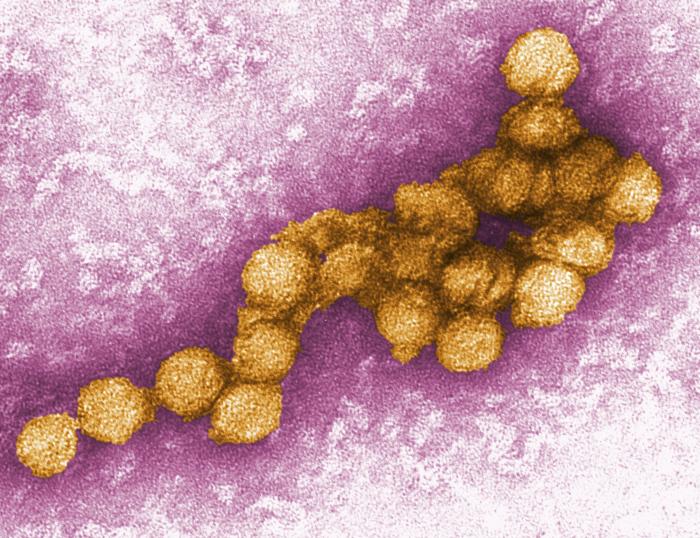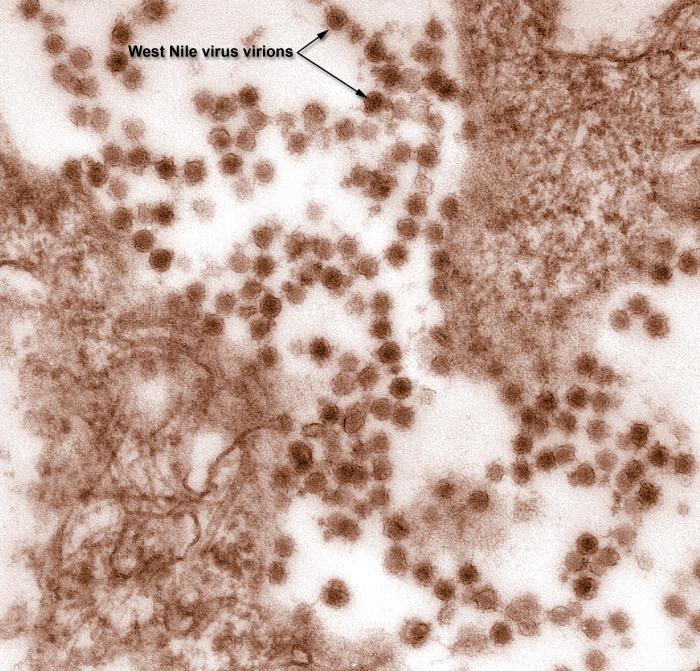West nile virus causes: Difference between revisions
Joao Silva (talk | contribs) No edit summary |
Joao Silva (talk | contribs) |
||
| Line 36: | Line 36: | ||
==Natural Reservoir== | ==Natural Reservoir== | ||
Although the West Nile virus can infect humans and different animals, birds are its natural reservoir. The life cycle of the virus is dependent on the transmission of the virus between mosquito and birds.<ref name="pmid23860989">{{cite journal| author=Petersen LR, Brault AC, Nasci RS| title=West Nile virus: review of the literature. | journal=JAMA | year= 2013 | volume= 310 | issue= 3 | pages= 308-15 | pmid=23860989 | doi=10.1001/jama.2013.8042 | pmc= | url=http://www.ncbi.nlm.nih.gov/entrez/eutils/elink.fcgi?dbfrom=pubmed&tool=sumsearch.org/cite&retmode=ref&cmd=prlinks&id=23860989 }} </ref><ref name="CampbellMarfin2002">{{cite journal|last1=Campbell|first1=Grant L|last2=Marfin|first2=Anthony A|last3=Lanciotti|first3=Robert S|last4=Gubler|first4=Duane J|title=West Nile virus|journal=The Lancet Infectious Diseases|volume=2|issue=9|year=2002|pages=519–529|issn=14733099|doi=10.1016/S1473-3099(02)00368-7}}</ref> | |||
==References== | ==References== | ||
{{Reflist|2}} | {{Reflist|2}} | ||
Revision as of 16:53, 11 September 2014
Editor-In-Chief: C. Michael Gibson, M.S., M.D. [1]
Overview
Taxonomy
Viruses; ssRNA viruses; ssRNA positive-strand viruses, no DNA stage; Flaviviridae; Flavivirus; Japanese encephalitis virus group[1]
Biology
 |
 |
West Nile virus is a member of Japanese encephalitis serocomplex and belongs to the genus Flavivirus, family Flaviviridae. The virus has an icosahedral symmetry, with a smooth surface.[4] It is an enveloped virus with a nucleocapsid core built of RNA and capsid proteins. Its genome is contained in a single stranded mRNA virus of about 11000 bp.[5] It contains a single ORF, a 5' UTR, and a 3' region which is not translated. The ORF contains a single polyprotein, that after processed and translated produces 3 smaller types of structure proteins and 7 of non-strutural proteins.
- Structure proteins are responsible for the formation of the viral particle and include:
- Envelope proteins
- Membrane proteins
- C proteins
- Non-structure proteins are responsible for viral replication, evasion of the immune system and assembly of virions, and include:
- NS1
- NS2A
- NS2B
- NS3
- NS4A
- NS4B
- NS5
The West Nile Virus may be classified in 5 phylogenetic lineages. Of these, only 1 and 2 have been identified as causative agents of disease in humans.[6] Lineage 1 may be subclassified into 3 other lineages, which predominate in certain parts of the world:[7]
- Lineage 1a - western hemisphere, Africa, the Middle East, and Europe
- Lineage 1b - Kunjin virus from Australasia
- Lineage 1c - virus in India
Tropism
Natural Reservoir
Although the West Nile virus can infect humans and different animals, birds are its natural reservoir. The life cycle of the virus is dependent on the transmission of the virus between mosquito and birds.[8][5]
References
- ↑ "West Nile Virus".
- ↑ "http://phil.cdc.gov/phil/details.asp". External link in
|title=(help) - ↑ "http://phil.cdc.gov/phil/details.asp". External link in
|title=(help) - ↑ Mukhopadhyay, S. (2003). "Structure of West Nile Virus". Science. 302 (5643): 248–248. doi:10.1126/science.1089316. ISSN 0036-8075.
- ↑ 5.0 5.1 Campbell, Grant L; Marfin, Anthony A; Lanciotti, Robert S; Gubler, Duane J (2002). "West Nile virus". The Lancet Infectious Diseases. 2 (9): 519–529. doi:10.1016/S1473-3099(02)00368-7. ISSN 1473-3099.
- ↑ "West Nile Virus" (PDF).
- ↑ Miller DL, Mauel MJ, Baldwin C, Burtle G, Ingram D, Hines ME; et al. (2003). "West Nile virus in farmed alligators". Emerg Infect Dis. 9 (7): 794–9. doi:10.3201/eid0907.030085. PMC 3023431. PMID 12890319.
- ↑ Petersen LR, Brault AC, Nasci RS (2013). "West Nile virus: review of the literature". JAMA. 310 (3): 308–15. doi:10.1001/jama.2013.8042. PMID 23860989.